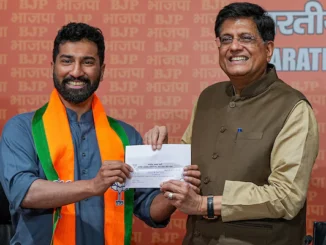
Durga Puja, also known as Durgotsava, or Sharodotsava, is an annual Hindu festival originating in the Indian subcontinent which reveres and pays homage to the Hindu goddess, Durga.
It is particularly popular and traditionally celebrated in the Indian states of Bihar, West Bengal, Assam, Odisha, Tripura, and the country of Bangladesh. The festival is observed in the Indian calendar month of Ashwin, which corresponds to September-October in the Gregorian calendar, and is a ten-day festival, of which the last five are of significance.
The dates of Durga Puja 2021
– Shashti – 11th October 2021
– Maha Saptami – 12th October 2021
– Maha Ashtami – 13th October 2021
– Maha Navami – 14th October 2021
– Viajaya Dashami – 15th October 2021
The puja is performed in homes and in public, the latter featuring a temporary stage and structural decorations (known as pandals). The festival is also marked by scripture recitations, performance arts, revelry, gift-giving, family visits, feasting, and public processions. Durga puja is an important festival in the Shaktism tradition of Hinduism.
As per Hindu scriptures, the festival marks the victory of goddess Durga in her battle against the shape-shifting asura, Mahishasura.[Thus, the festival epitomizes the victory of good over evil, though it is also in part a harvest festival celebrating the goddess as the motherly power behind all of life and creation. Durga puja coincides with Navaratri and Dussehra celebrations observed by other traditions of Hinduism,in which the Ram Lila dance-drama is enacted, celebrating the victory of Rama against Ravana, and effigies of Ravana are burnt.
The primary goddess revered during Durga Puja is Durga but celebrations also include other major deities of Hinduism such as Lakshmi (the goddess of wealth and prosperity), Saraswati (the goddess of knowledge and music), Ganesha (the god of good beginnings), and Kartikeya (the god of war). In Bengali and Odia traditions, these deities are considered to be Durga’s children and Durga puja is believed to commemorate Durga’s visit to her natal home with her beloved children. The festival is preceded by Mahalaya, which is believed to mark the start of Durga’s journey to her natal home. Primary celebrations begin on the sixth day (Shasthi), on which the goddess is welcome with rituals. The festival ends on the tenth day (Vijaya Dashami) when devotees embark on a procession carrying the worshipped clay sculpture-idols to a river, or other water body, and immerse them, symbolic of her return to the divine cosmos and her marital home with Shiva in Kailash. Regional and community variations in celebration of the festival and rituals observed exist.
Durga puja is an old tradition of Hinduism, though its exact origins are unclear. Surviving manuscripts from the 14th-century provide guidelines for Durga puja, while historical records suggest that the royalty and wealthy families were sponsoring major Durga puja festivities since at least the 16th-century.The prominence of Durga Puja increased during the British Raj in the provinces of Bengal, Odisha and Assam.
In today’s time, the importance of Durga puja is as much as a social and cultural festival as a religious one, wherever it is observed.
Over the years, Durga Puja has become an inseparable part of Indian culture with innumerable people celebrating this festival in their own unique way while pertaining to tradition.
Rituals and practices
Durga puja is a ten-day event, of which the last five days involve certain rituals and practices. The festival begins with Mahalaya, a day on which Hindus perform tarpa?a by offering water and food to their dead ancestors. The day also marks the advent of Durga from her mythological marital home in Kailash. The next significant day of the festival is the sixth day (Sashthi), on which devotees welcomes the goddess and festive celebrations are inaugurated. On the seventh day (Saptami), eighth (Ashtami) and ninth (Navami) days, the goddess along with Lakshmi, Saraswati, Ganesha, and Kartikeya are revered and these days mark the main days of worship with recitation of scriptures, puja, legends of Durga in Devi Mahatmya, social visits to elaborately decorated and illuminated pandals (temporary structures meant for hosting the puja), among others.
Durga puja is, in part, a post-monsoon harvest festival observed on the same days in the Shaktism tradition of Hinduism as those in its other traditions. The practice of including a bundle of nine different plants, called navapatrika, as a symbolism of Durga, is a testament practice to its agricultural importance. The typically selected plants include not only representative important crops, but also non-crops. This probably signifies the Hindu belief that the goddess is “not merely the power inherent in the growth of crops but the power inherent in all vegetation”. The festival is a social and public event in the eastern and northeastern states of India, where it dominates religious and socio-cultural life, with temporary pandals built at community squares, roadside shrines, and temples. The festival is also observed by some Shakta Hindus as a private home-based festival. The festival starts at twilight with prayers to Saraswati. She is believed to be another aspect of goddess Durga, and who is the external and internal activity of all existence, in everything and everywhere. This is typically also the day on which the eyes of the deities on the representative clay sculpture-idols are painted, bringing them to a lifelike appearance. The day also marks prayers to Ganesha and visit to pandals temples.[
Day two to five mark the remembrance of the goddess and her manifestations, such as Kumari (goddess of fertility), Mai (mother), Ajima (grandmother), Lakshmi (goddess of wealth) and in some regions as the Saptamatrikas (seven mothers) or Navadurga (nine aspects of Durga). On the sixth day major festivities and social celebrations start. The first nine days overlap with Navaratri festivities in other traditions of Hinduism. The puja rituals involve mantras (words manifesting spiritual transformation), shlokas (holy verses), chants and arati, and offerings. These also include Vedic chants and recitations of the Devi Mahatmya text in Sanskrit.The shlokas and mantras praise the divinity of the goddess; according to the shlokas Durga is omnipresent as the embodiment of power, nourishment, memory, forbearance, faith, forgiveness, intellect, wealth, emotions, desires, beauty, satisfaction, righteousness, fulfillment and peace. The specific practices vary by region.





Be the first to comment